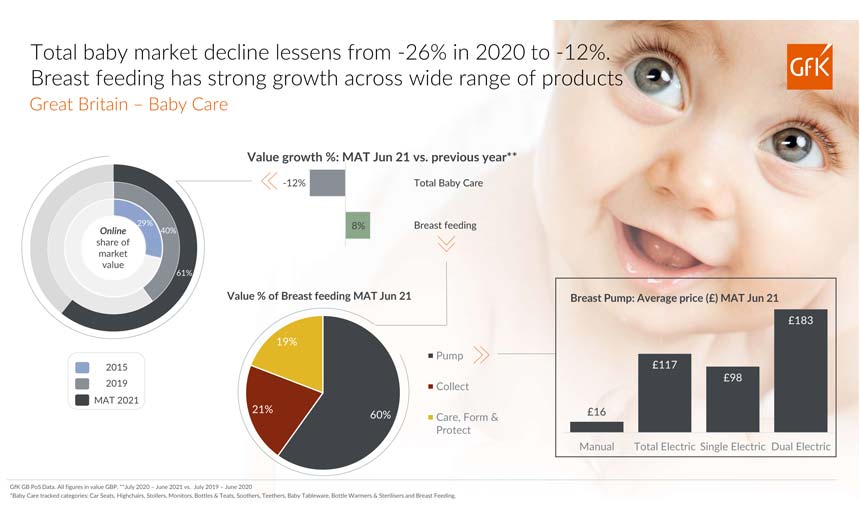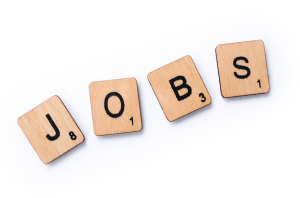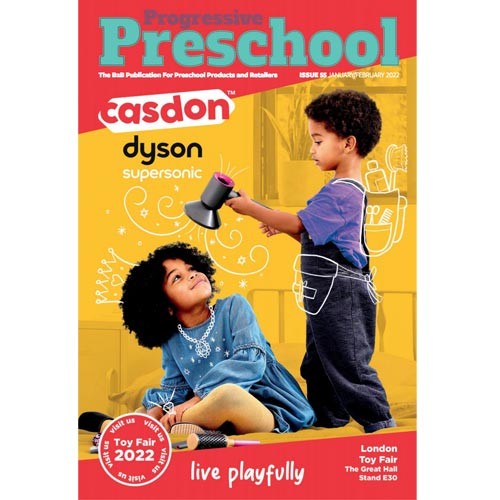GfK’s insight director, Helen Collins takes a look at how the breast feeding market has performed over the past 12 months.
In the 12 months to June 2021 the baby care market declined by -2% in volume and -12% in value driven by the more premium categories – strollers (-32%) and car seats (-6%). Both of these markets were more strongly affected by the ‘stay at home’ message during lock down. The first six months of 2021 has, however, been more positive with a growth of 12% for car seats and a lessened decline of -2% in strollers driving total baby care value up +6%.
A trend seen across the consumer durables market is the shift to online sales. In 2015 just 28.5% of baby care value went through an online transaction. This slowly increased over the next four years to 40% in 2019 and then jumped to 61% in the last 12 months. There are multiple factors here; firstly a number of key baby retailers have closed in recent years which has reduced the options on the high street; more online pure players have started up and many retailers have improved their online offering including upgraded websites, increased choice and better payment and delivery options, then Covid-19 came along and non-essential stores were forced to close. Despite stores now re-opening we don’t expect online sales to fall back to pre-pandemic levels as many consumers’ shopping habits will have changed for good.
Room for optimism
There is room for optimism though, Joe Staton, client strategy director at GfK, says. “Consumer confidence edged ahead of its March 2020 pre-lockdown headline score by two points to -7 in July. This means it has now held firm or improved for six months in a row. Personal finance expectations for the next 12 months remain strong and there’s a dramatic jump this month in our major purchase sub-measure with shoppers agreeing that now is the ‘right time to buy’.
“The healthy seven-point rise in the major purchase measure aligns with strong retail growth figures that reflect the gradual unlocking of the UK high street and release of pent-up demand as Brits hit shops, restaurants and venues. However, threats from increasing consumer price inflation, rising Covid infection figures, and the looming end of furlough and the Job Retention Scheme could put the brakes on this rebound.
“Consumers are aware of these pressures, judging by the latest fall from -2 to -5 in their view of the general economy in the coming 12 months. What happens across the remaining summer months will frame consumer confidence for the rest of 2021 and beyond.”

Feeding time
Outside of Strollers and Bottles, all other baby markets have seen an increased average price year on year – the largest jumps have come from High Chairs (+18%), Monitors (+12%) and Breast Feeding (+12%).
The Breast Feeding market has been a strong performer over the last 12 months, growing by 8% in value.
The market is made up of five types – ‘care’, ‘form’ and ’protect’ which includes products such as creams, care pads, nipple shields and formers; ‘breast pumps’ which can be electric or manual, single or dual; and ‘collect’ which includes all products dedicated to collect or absorb mother’s milk.
Combined, the care, form and protect markets account for 19% of total breast feeding value, growing by 14% year on year with a slight rise of 3% in average price.
‘Collect’ contributes 21% market value and is the only sub segment to decline year on year (-9.5%). Considering the total breast feeding market has grown, this decline isn’t driven by less mothers choosing to breast feed but more likely by mothers being stuck at home during much of lockdown and therefore relying less on building up milk reserves in the freezer for a later date.
‘Pump’ is the largest value segment at 60% of total breast feeding and has grown in value by 14% year on year despite declining -1% in volume.
There is a broad range of breast pumps in the market in terms of price and functionality. Mothers can choose a manual pump with an average price of £16 but ranging from as low as £5 up to £50, or if they prefer electric, they have the choice of a single pump with an average price tag of £98 or dual with a whopping £183 price attached. New entrants to the market over the last few years have driven up the average price of electric pumps from £70 to £117.
Changes to legislation and innovation are consistent drivers in the baby care markets, but with the furlough scheme ending, increased CPI and growing Covid infection rates we’ll have to see where consumer’s priorities for spending lie over the rest of 2021.






















